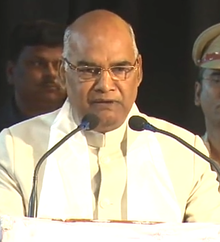President of the Republic of India
| President of the Republic of India | |
|---|---|

|
|

|
|
| Style |
Honourable (within India) His/ Her Excellency (outside India) |
| Residence | Rashtrapati Bhavan |
| Appointer | The Electoral College of India |
| Term length | Five years. No term limits are imposed on the office. |
| Inaugural holder |
Rajendra Prasad 26 January 1950 |
| Formation |
The Constitution of India January 26, 1950 |
| Deputy | Vice President of India |
| Salary | ₹150,000 (US$2,300) (per month) |
| Website | President of India |
The President of the Republic of India is the head of state of India and the commander-in-chief of the Indian Armed Forces.
The President is indirectly elected by an electoral college comprising the Parliament of India (both houses) and the Legislative Assemblies of each of India's states and territories, who themselves are all directly elected.
Although the of the Constitution of India states that the President can exercise his powers directly or by subordinate authority, with few exceptions, all of the executive powers vested in the President are, in practice, exercised by the Prime Minister (a subordinate authority) with the help of the Council of Ministers. The President is bound by the constitution to act on the advice of the Prime Minister and Cabinet as long as the advice is not violating the constitution.
India achieved independence from the British on 15 August 1947, initially as a Dominion within the Commonwealth of Nations with George VI as king, represented in the country by a governor-general. Still, following this, the Constituent Assembly of India, under the leadership of Dr.B.R.Ambedkar, undertook the process of drafting a completely new constitution for the country. The Constitution of India was eventually enacted on 26 November 1949 and came into force on 26 January 1950, making India a republic. The offices of monarch and governor-general were replaced by the new office of President of India, with Rajendra Prasad as the first incumbent.
...
Wikipedia

